《固体物理学》课程教学课件(PPT讲稿)Chapter 1 Crystal Structure 1.7 Lattice Sites in a Cubic Unit Cell 1.8 crystal plane and miller index
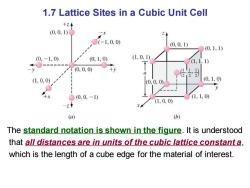
1.7 Lattice Sites in a Cubic Unit Cell +z (0,0,1) (-1,0,0) (0,0,1) (0,1,1) (0,-1,0) (0,1,0) (1,0,1) (1,1, 1) y 1(0.0,0) +y 0 (1,0,0) (0,0,0) (0,1,0) ●0,0,-1) (1,1,0) (1,0,0) (a) (b) The standard notation is shown in the figure.It is understood that all distances are in units of the cubic lattice constant a, which is the length of a cube edge for the material of interest
1.7 Lattice Sites in a Cubic Unit Cell The standard notation is shown in the figure. It is understood that all distances are in units of the cubic lattice constant a, which is the length of a cube edge for the material of interest
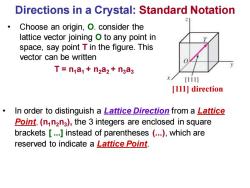
Directions in a Crystal:Standard Notation Choose an origin,O.consider the lattice vector joining o to any point in space,say point T in the figure.This vector can be written T=n a+n2a2+n3a3 [111 [111]direction In order to distinguish a Lattice Direction from a Lattice Point,(nin2n3),the 3 integers are enclosed in square brackets [.instead of parentheses (.)which are reserved to indicate a Lattice Point
Directions in a Crystal: Standard Notation • Choose an origin, O. consider the lattice vector joining O to any point in space, say point T in the figure. This vector can be written T = n1a1 + n2a2 + n3a3 [111] direction • In order to distinguish a Lattice Direction from a Lattice Point, (n1n2n3 ), the 3 integers are enclosed in square brackets [ .] instead of parentheses (.), which are reserved to indicate a Lattice Point
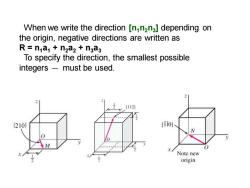
When we write the direction [nn2n3]depending on the origin,negative directions are written as R=n a1+n2a2+n3a3 To specify the direction,the smallest possible integers must be used. [112] [210] [ii01 Note new origin
210 When we write the direction [n1n2n3 ] depending on the origin, negative directions are written as R = n1a1 + n2a2 + n3a3 To specify the direction, the smallest possible integers must be used
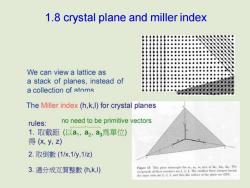
1.8 crystal plane and miller index We can view a lattice as a stack of planes,instead of a collection of atoms The Miller index(h,k,I)for crystal planes rules: no need to be primitive vectors 1.取截距(以a1,a2,a3篇單位) 得(,y,z) 2.取倒數(1/x,1y,1/2) 3.通分成互質整數(h,k,) Figure 15 Thie pline interovpts the a ay ates at 3a 2ap 2a The the saue ratin are23.3.and thas the indices of the plane are
1.8 crystal plane and miller index
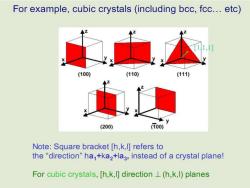
For example,cubic crystals (including bcc,fcc.etc) (100) (110) (111) (200) 00) Note:Square bracket [h,k,I]refers to the"direction"ha,+kaz+la3,instead of a crystal plane! For cubic crystals,[h,k,I]direction L(h,k,l)planes
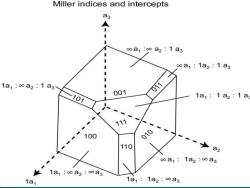
Miller indices and intercepts a3 ∞a1:∞a2:1a3 ∞a1:1a2:1ag 1a1:∞a2:1a3 001 011 101 1a1:1a2:1a 111 100 010 110 ∞a1:1a2:a3 1a1:∞a2:∞a3 1a1 1a1:1a2:∞a3
Crystal Structure 6
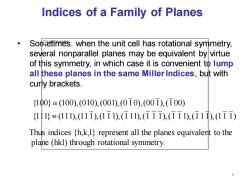
Indices of a Family of Planes Sonetimes.when the unit cell has rotational symmetry, several nonparallel planes may be equivalent by virtue of this symmetry,in which case it is convenient to lump all these planes in the same Miller Indices,but with curly brackets. {100}=(100),(010),(001),(010),(001),(100) {111}≡(111),111),(111),(111),(111),(111),(11),(11I) Thus indices (h,k,1}represent all the planes equivalent to the plane (hkl)through rotational symmetry
7 • Sometimes. when the unit cell has rotational symmetry, several nonparallel planes may be equivalent by virtue of this symmetry, in which case it is convenient to lump all these planes in the same Miller Indices, but with curly brackets. Thus indices {h,k,l} represent all the planes equivalent to the plane (hkl) through rotational symmetry. {111} (111),(111),(111),(111),(1 1 1),(1 11),(111),(11 1) {100} (100),(010),(001),(010),(001),(100) Indices of a Family of Planes
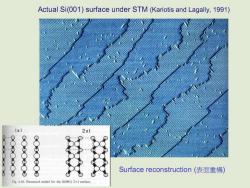
Actual Si(001)surface under STM(Kariotis and Lagally,1991) Surface reconstruction(表面重構) Fig.4.16.Structural model for the Si(001)2x1 surface
按次数下载不扣除下载券;
注册用户24小时内重复下载只扣除一次;
顺序:VIP每日次数-->可用次数-->下载券;
- 《固体物理学》课程教学资源(参考资料)词汇汉英对照.pdf
- 《固体物理学》课程授课教案(讲义)第五章 能带理论.pdf
- 《固体物理学》课程授课教案(讲义)第一章 晶体结构.pdf
- 《固体物理学》课程授课教案(讲义)第三章 晶体的结合.pdf
- 《固体物理学》课程授课教案(讲义)第四章 晶格振动.pdf
- 《固体物理学》课程授课教案(讲义)第二章 晶体结构的测定.pdf
- 《固体物理学》课程授课教案(讲义)晶体能带结构理解电导特性.doc
- 《固体物理学》课程授课教案(讲义)第六章 固体电子论基础.pdf
- 《固体物理学》课程授课教案(讲义)紧束缚近似理论研究性教学教案设计.doc
- 《固体物理学》课程授课教案(讲义)非谐效应——热膨胀研究性教学教案设计.doc
- 《固体物理学》课程教学大纲 Solid State Physics.pdf
- 《半导体工艺原理》课程教学课件(PPT讲稿)第4章 晶圆制造与外延硅生长.ppt
- 《半导体工艺原理》课程教学课件(PPT讲稿)第2章 集成电路工艺介绍.ppt
- 《半导体工艺原理》课程教学课件(PPT讲稿)第10章 化学气相沉积与电介质薄膜.ppt
- 《半导体工艺原理》课程教学课件(PPT讲稿)第5章 加热工艺.ppt
- 《半导体工艺原理》课程教学课件(PPT讲稿)第1章 半导体制程技术导论.ppt
- 《半导体工艺原理》课程教学课件(PPT讲稿)第2章 集成电路工艺介绍.ppt
- 《半导体工艺原理》课程教学课件(PPT讲稿)第3章 半导体基础原理、组件与制程.ppt
- 《半导体工艺原理》课程教学课件(PPT讲稿)第6章 光刻工艺.ppt
- 《半导体工艺原理》课程教学课件(PPT讲稿)第7章 等离子体的基础原理.ppt
- 《固体物理学》课程教学课件(PPT讲稿)Chapter 1 Crystal Structure 1.6 typical crystal structure.ppt
- 《固体物理学》课程教学课件(PPT讲稿)Chapter 1 Crystal Structure 1.1 Elementary Crystallography 1.2 Crystal Structure ≡ Lattice + Basis 1.3 Lattice Translation Vectors 1.4 Non-Bravais Lattices 1.5 Wigner-Seitz Method.ppt
- 《固体物理学》课程教学课件(PPT讲稿)Introduction.ppt
- 《固体物理学》课程教学课件(PPT讲稿)Chapter 1 Crystal Structure(Supplement - microstructure and crystal system).ppt
- 《固体物理学》课程教学课件(PPT讲稿)Chapter 1 Crystal Structure 1.9 Elements of Symmetry 1.10 Space groups 1.11 7 crystal system and 14 Bravis Lattice.ppt
- 《固体物理学》课程教学课件(PPT讲稿)Chapter 2 Wave Diffraction & the Reciprocal Lattice(supplement - Review & Overview of X-Rays).ppt
- 《固体物理学》课程教学课件(PPT讲稿)Chapter 2 Wave Diffraction & the Reciprocal Lattice 2.6 X-Ray Diffraction Methods 2.7 Applications of XRD.ppt
- 《固体物理学》课程教学课件(PPT讲稿)Chapter 2 Wave Diffraction & the Reciprocal Lattice(2.1-2.5).ppt
- 《固体物理学》课程教学课件(PPT讲稿)Chapter 3 Interatomic Bonding 3.3 The cohesive energy for ionic crystal.ppt
- 《固体物理学》课程教学课件(PPT讲稿)Chapter 3 Interatomic Bonding 3(Supplement - Rules of crystal binding).ppt
- 《固体物理学》课程教学课件(PPT讲稿)Chapter 3 Interatomic Bonding 3.1 General crystal binding 3.2 typical binding.ppt
- 《固体物理学》课程教学课件(PPT讲稿)Chapter 4 lattice dynamics and lattice capacity 4.1 Normal Modes of Vibration 4.2 Density of States 4.3 Harmonic approximation and normal mode coordinates 4.4 phonon.ppt
- 《固体物理学》课程教学课件(PPT讲稿)Chapter 4 lattice dynamics and lattice capacity 4.5 Heat capacity of the lattice.ppt
- 《固体物理学》课程教学课件(PPT讲稿)Chapter 5 band theory 5.1 general background and approximations 5.2 Bloch’s Theorem.ppt
- 《固体物理学》课程教学课件(PPT讲稿)Chapter 4 lattice dynamics and lattice capacity 4.6 Anharmonic Effects 4.7 Equation of states for Lattice 4.8 Experimental methods for the determinations of lattice vibration spectroscopy.ppt
- 《固体物理学》课程教学课件(PPT讲稿)Chapter 4 lattice dynamics and lattice capacity 4(supplement - Thermal Expansion of Glass).ppt
- 《固体物理学》课程教学课件(PPT讲稿)Chapter 5 band theory 5.5 The symmetry of bands.ppt
- 《固体物理学》课程教学课件(PPT讲稿)Chapter 5 band theory 5.3 Nearly Free Electron 5.4 BZ and energy bands.ppt
- 《固体物理学》课程教学课件(PPT讲稿)Chapter 5 band theory 5.4 Tight Binding Approximation(TBA).ppt
- 《固体物理学》课程教学课件(PPT讲稿)Chapter 6 Electron motion in the crystal 6.1 The quasi-classical description of Bloch electrons 6.2. Electron quasi-momentum 6.3 The accelerated velocity and effective mass.ppt
